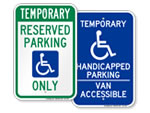Sign Materials
A number of parking sign companies have started to sell signs using different thicknesses and types of metal. Let’s go through common parking sign material options and look at the pros and cons of each. I will only examine different sign backing options and not survey different reflectivity options (which may be covered in a later study).
Metal Parking Signs
Steel: This was the common parking sign material in the 1940’s – 1950’s. Often coated on the back to prevent rust, these signs were still vulnerable. During the 1960’s, aluminum parking signs become the norm. Another significant drawback to steel parking signs remains weight. Hoisting and then installing a steel parking sign (which typically weighs three times more than an aluminum sign) become a major negative for parking sign installation crews.
Aluminum – 40 mils Thick: This is the preferred thickness for retail-oriented novelty parking signs. Too thin to be used regularly on post mount applications, 40 mils thick parking signs are typically mounted onto walls.
Aluminum – 63 mils Thick: This remains the most common material for parking signs that are 12” x 18” or smaller and it is specified by the virtually all of the government bids. The common aluminum specified is 3105-H38.
Aluminum – 80 mils Thick: Used for larger parking signs (18” x 24” and larger). These 80 mils thick signs use 3105-H38 aluminum. Many smaller parking sign manufactures in an effort to limit raw material inventories stock a single thickness and thus make an 80 mils thick 12” x 18” signs. It is rare to find state or city sign bids that specify 80 mils aluminum for their mainstay 12” x 18” parking signs.

Embossed Aluminum Sign
Embossed Aluminum: In this construction, the legend of the parking sign has a 3-D appearance. During manufacture, the aluminum sign is put onto a press with a die having the same shape as the legend. Extreme pressure is needed to emboss these aluminum signs. Thinner aluminum parking signs are easier to emboss. Many 40 mils thick aluminum signs, for the novelty parking sign market, use this construction. Most embossed parking signs are not reflective – hence not suitable for most parking lots. Engineer grade film can be mounted onto embossed parking signs. Most state license plates are made this way.
Porcelain: Porcelain parking signs are the durability champions – as long as they are not hit with a hard object! Common in the 1930’s – 1950’s , many of these early porcelain parking signs can still be found in use. No other parking sign lasts longer outside. The problems with porcelain are several fold: very high weight, chips and [then] rusts after being hit, non reflective and very high cost.
Plastic Parking Signs
Tyvek® / Polyolefin: Temporary parking signs need to be minimally durable. Although in some cases a heavy duty paper would suffice, most temporary parking signs are made from a Tyvek® or a thin polyolefin material. Generally, laser printed, temporary parking signs are expected to last 1-14 days and are often used for events. For convenience, temporary parking signs can be ordered in a roll or in a book form. Temporary parking signs are generally under $1.00 each and are considered disposable.
Polyethylene: These plastic parking signs range from a thickness of 60 mils to 125 mils. Usually screen printed directly onto a corona treated HDPE sheet, these signs have a 3-7 year outdoor durability. Alternatively, a sign manufacture may choose to laminate a reflective film to an HDPE base. This process can be fraught with difficulty in that the low surface energy of the HDPE makes adhesion difficult and also there are problems with out-gassing. Out-gassing has been a major source of warranty claims in the past for faulty parking signs and, as a result, most reflective film manufactures now specify that their warranty is only valid when their film is used on certain grades of metal. Polyethylene parking signs have a retail price of $10 to $20.
Polystyrene: These rigid plastic signs are generally screen printed and, in most cases, are imported from China. They are not reflective and, unfortunately, do not meet state and federal rules. But, they are in expensive! They have a retail price of $4 to $10 each. Primary applications include personal parking garage signs, “gag gift” parking signs and temporary event parking signs. As the pricing for metal signs have decreased, the share of the parking sign market represented by polyethylene signs has declined.
Conclusion
As you can imagine, there are many, many other different parking sign material options. Only the better selling and more economical types are shown here.
When you are choosing a parking sign, use this material crib sheet to help narrow your material choices. In the end, you need to balance the cost of the sign against the intended end use. Although not all parking signs need to have superior durability, the trend in the industry is towards far better pricing on metal parking signs and this has meant a dramatic increase in the number of metal parking signs now sold.












